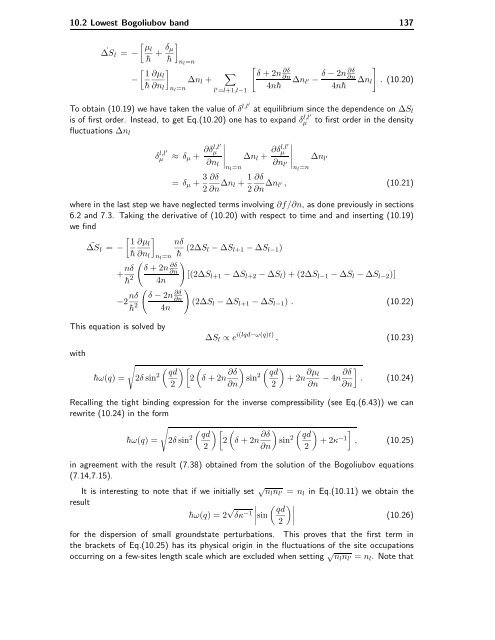Bose-Einstein Condensates in Rotating Traps and Optical ... - BEC
Bose-Einstein Condensates in Rotating Traps and Optical ... - BEC
Bose-Einstein Condensates in Rotating Traps and Optical ... - BEC
You also want an ePaper? Increase the reach of your titles
YUMPU automatically turns print PDFs into web optimized ePapers that Google loves.
10.2 Lowest Bogoliubov b<strong>and</strong> 137<br />
<br />
µl<br />
∆Sl<br />
˙ = −<br />
<br />
δµ<br />
+<br />
¯h ¯h<br />
<br />
1 ∂µl<br />
−<br />
¯h ∂nl<br />
nl=n<br />
∆nl +<br />
nl=n<br />
<br />
l ′ =l+1,l−1<br />
δ +2n ∂δ<br />
∂n<br />
4n¯h<br />
∂δ δ − 2n ∂n<br />
∆nl ′ −<br />
4n¯h ∆nl<br />
<br />
. (10.20)<br />
To obta<strong>in</strong> (10.19) we have taken the value of δl,l′ at equilibrium s<strong>in</strong>ce the dependence on ∆Sl<br />
is of first order. Instead, to get Eq.(10.20) one has to exp<strong>and</strong> δ l,l′<br />
µ to first order <strong>in</strong> the density<br />
fluctuations ∆nl<br />
δ l,l′<br />
µ ≈ δµ + ∂δl,l′<br />
<br />
<br />
µ <br />
∆nl +<br />
∂nl <br />
nl=n<br />
∂δl,l′ µ<br />
∂nl ′<br />
<br />
<br />
<br />
∆nl<br />
<br />
nl=n<br />
′<br />
= δµ + 3 ∂δ<br />
2 ∂n ∆nl + 1 ∂δ<br />
∆nl ′ , (10.21)<br />
2 ∂n<br />
where <strong>in</strong> the last step we have neglected terms <strong>in</strong>volv<strong>in</strong>g ∂f/∂n, as done previously <strong>in</strong> sections<br />
6.2 <strong>and</strong> 7.3. Tak<strong>in</strong>g the derivative of (10.20) with respect to time <strong>and</strong> <strong>and</strong> <strong>in</strong>sert<strong>in</strong>g (10.19)<br />
we f<strong>in</strong>d<br />
<br />
∆Sl<br />
¨<br />
1 ∂µl nδ<br />
= −<br />
¯h ∂nl nl=n ¯h (2∆Sl − ∆Sl+1 − ∆Sl−1)<br />
+ nδ<br />
¯h 2<br />
<br />
∂δ δ +2n∂n [(2∆Sl+1 − ∆Sl+2 − ∆Sl)+(2∆Sl−1−∆Sl − ∆Sl−2)]<br />
4n<br />
<br />
∂δ δ − 2n ∂n (2∆Sl − ∆Sl+1 − ∆Sl−1) . (10.22)<br />
4n<br />
−2 nδ<br />
¯h 2<br />
This equation is solved by<br />
with<br />
<br />
¯hω(q) = 2δ s<strong>in</strong>2 <br />
qd<br />
2<br />
2<br />
∆Sl ∝ e i(lqd−ω(q)t) , (10.23)<br />
δ +2n ∂δ<br />
∂n<br />
<br />
s<strong>in</strong> 2<br />
<br />
qd<br />
+2n<br />
2<br />
∂µl<br />
∂n<br />
<br />
∂δ<br />
− 4n . (10.24)<br />
∂n<br />
Recall<strong>in</strong>g the tight b<strong>in</strong>d<strong>in</strong>g expression for the <strong>in</strong>verse compressibility (see Eq.(6.43)) we can<br />
rewrite (10.24) <strong>in</strong> the form<br />
¯hω(q) =<br />
<br />
2δ s<strong>in</strong> 2<br />
<br />
qd<br />
2<br />
2<br />
δ +2n ∂δ<br />
∂n<br />
<br />
s<strong>in</strong> 2<br />
<br />
qd<br />
+2κ<br />
2<br />
−1<br />
<br />
, (10.25)<br />
<strong>in</strong> agreement with the result (7.38) obta<strong>in</strong>ed from the solution of the Bogoliubov equations<br />
(7.14,7.15).<br />
It is <strong>in</strong>terest<strong>in</strong>g to note that if we <strong>in</strong>itially set √ nlnl ′ = nl <strong>in</strong> Eq.(10.11) we obta<strong>in</strong> the<br />
result<br />
¯hω(q) =2 √ δκ−1 <br />
<br />
<br />
s<strong>in</strong> <br />
qd <br />
2<br />
(10.26)<br />
for the dispersion of small groundstate perturbations. This proves that the first term <strong>in</strong><br />
the brackets of Eq.(10.25) has its physical orig<strong>in</strong> <strong>in</strong> the fluctuations of the site occupations<br />
occurr<strong>in</strong>g on a few-sites length scale which are excluded when sett<strong>in</strong>g √ nlnl ′ = nl. Note that




